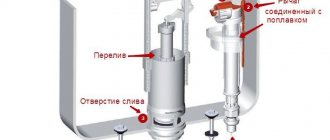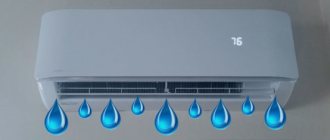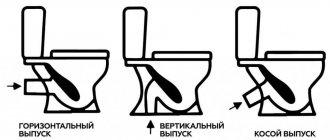Number of views: 2,674
When a toilet tank leaks in your home, water consumption can increase up to 10 times. The reasons may be different: valve malfunction, failure of the float mechanism, wear of the hoses. You can fix all this yourself, without resorting to the services of a plumber.
In this article we will look at the main causes of tank leakage and their elimination. We will also tell you about the prevention of the toilet flush system in order to avoid them in the future.
Diagram and details
Any circuit consists of several nodes:
- A water drainage device is a drain pipe, a water release mechanism and a valve that stops the flow of water into the toilet. When we press the drain button, the valve rises. Water flows out of the tank at high speed through the drain pipe.
- A shut-off mechanism is a faucet that automatically turns off the water. The tap opens as soon as the water level has decreased. The float, as the tank is filled, will rise to a certain height and close the tap.
- Overflow system - protects the apartment from flooding if the locking mechanism fails. When the water level rises above a certain value, the overflow system ensures that it flows into the toilet.
What is needed for repair?
For repairs, you will need the simplest tools that are found in every home: screwdrivers, a work knife, a hammer, a piece of sandpaper, pliers or a set of wrenches. You will also need sealing material - tow with grease and plumbing sealant.
It is also worth preparing a piece of rags to wipe your hands while working. If the water supply valve for the toilet is located in another room, it is better to work with an assistant.
How to fix a leak with your own hands?
First of all, you need to carefully remove the tank cap. Start by checking the valve that shuts off the liquid supply. Raise the float until the water stops flowing. If the leak is eliminated, you need to adjust the position of the float on the rod.
If this does not help, you need to remove the drain fittings and inspect the condition of the sealing rubber. Often it is enough to clean it of dirt to restore normal operation of the mechanism.
If this does not help, you will have to disassemble the tank in search of failed parts. These could be sealing gaskets between the tank and the shelf, bolts, tightening parts or parts of the drain fittings.
- The float may leak water due to a clogged rubber band. To clean it, you need to disassemble the float lever mounting assembly. After disassembly, the gaskets are washed and the rubber on the lever is replaced (it often develops wear). Video instructions will help you understand how this work is done:
- Another problem area is the rubber locking mechanism. Over time, it warps and the valve begins to jam. The problem is that with the low cost of the gasket itself, this part may not be available in the store. Buying entire fittings (for 800–900 rubles) for the sake of a 15-ruble elastic band is unprofitable. It is worth choosing a more or less suitable elastic band from the domestic range, cutting it and putting it in place. We offer video instructions for this operation:
- If you decide to change the entire fittings, you will have to turn off the water supply and empty the tank. Then unscrew the water supply hose with a wrench (a little liquid may spill out - replace the container). Then unscrew the fasteners and remove the tank. This will allow you to get close to the plastic nuts holding the reinforcement. We unscrew them, remove the shut-off valve and the float assembly, and install new parts. All stages of work are shown in the video:
Such repairs are already quite complicated for a novice plumber; it is better to seek help from an experienced specialist. But if this is not possible, you can figure it out yourself. The main thing is to do everything slowly, periodically checking the instructions for the fittings. Good luck with your work!
Signs of leakage
If the tank is leaking, you can observe the following:
- you can hear falling drops of water or a flowing stream;
- you can see rusty stains, lime deposits on the walls of the tank;
- a small wet trace is visible in the toilet bowl, which remains after flushing;
- the appearance of condensation on the outside or on the hoses;
- The water does not go away quickly after pressing the button.
If the water does not drain quickly or the level is incorrect, then the water pressure is not sufficient to pass the waste through the water seal. And some of it remains in the toilet bowl.
As soon as you detect one of the listed symptoms, you need to determine the cause and eliminate the problem.
Preventive measures
To prevent a situation where a toilet tank leaks with or without a button, you should regularly carry out certain preventive procedures, as well as follow the operating rules.
Prevention may include the following:
- minimize the likelihood of mechanical deformation of the toilet;
- minimize sudden temperature changes;
- clean the toilet bowl and cistern every six months;
- regularly check the condition of plumbing components, fittings and other parts so that they cannot leak;
- avoid condensation.
Thus, if the plumbing is leaking, you can simply carry out the repair yourself, without turning to a master plumber. First of all, you need to determine what is the reason that the tank is leaking.
It is important to remember that timely preventive procedures will increase the service life of plumbing and sewerage systems in general. If a malfunction is detected, it is recommended to fix minor problems first and then proceed to major damage.
List of required tools
In order to eliminate the leak, you need to acquire some tools and consumables. During the repair process, it is necessary to replace unsuitable seals, hoses, and gaskets.
When the toilet cistern is leaking, you may need:
- sealant for plumbing work (silicone);
- sandpaper;
- limescale remover;
- Screwdriver Set;
- knife;
- pliers;
- a set of keys;
- fum tape (sealing tape for water).
External damage
Such breakdowns occur due to incorrect installation or non-compliance with the operating rules of the device. Let's look at the most common problems and their solutions.
You may be interested in the article “Soldering polypropylene pipes: temperature table, installation instructions + top best pp systems” Go>>
Crack in the base of the toilet
If you pour hot water into the toilet or drop something heavy, the toilet bowl may crack.
How to repair such a crack if it is at the base of the toilet:
- Prevent crack enlargement. Use a small drill to make small indentations along the edges of the crack.
- Sand the edges of the crack with sandpaper.
- Glue the earthenware with epoxy resin or use two-contact glue.
- Do not use the device until it is completely dry.
- If the glue fails, you will have to replace the bathroom.
The fasteners are not tightened tightly enough
If, shortly after installing the toilet, drops of water appear at the connection between the tank and the bowl, then the clamping nuts may not be tightened tightly. Therefore, the tank did not move much.
Tighten the nuts. By lightly rocking the drain tank, check whether they are screwed on well.
The toilet bowl burst
If you stand on the toilet bowl with your feet, large cracks may appear. Water will begin to leak through the cracks. In this case, repairs will not be possible; you will have to replace the toilet with a new one.
Why the tank leaks - the main reasons
If you are wondering why the toilet tank is leaking, then the problem has already occurred. Now it remains to find out the reason why this may happen. The most common is ordinary overflow, in which excess liquid is washed away. There are several main factors that in most cases lead to disruption:
- deterioration of the elastic properties of the rubber gasket. Over time, this material wears out, as a result of which the water flow cannot be tightly blocked and the plumbing leaks. The deformed part allows water to pass through perfectly;
- The rubber gasket has not lost its elasticity or deformed, but it does not fit very tightly into the outlet hole located next to the valve mechanism. Due to loose pressing of the part, the toilet cistern leaks;
- The valve train pin has suffered corrosive deformation or physical damage. This part keeps the float in the required position, but during prolonged use the element wears out;
- the valve body was damaged - another cause of leakage. However, the cracks that cause the toilet cistern to leak occur only on plastic products. If parts made of brass are installed, such problems will not arise, because... brass components are known for increased strength.
Other common reasons for a leaking toilet tank include:
- damage to bolts and other fasteners connecting the flush tank and toilet. After a long period of use, metal elements often corrode, and plastic elements often break;
- if there is a leak from under the toilet tank when flushing, then the problem may be in the bulb, which has lost its elasticity over time. After prolonged use, this part loses its original properties, as a result of which the ability to acquire the required shape is lost.;
- displacement of the lever fixing the position of the float. This can occur due to prolonged use as a result of which the float loses its tightness. Therefore, liquid may enter the float. Sometimes low quality components also cause a similar malfunction and plumbing leaks;
- breakdown of the siphon or tank hoses;
- Water may leak between the tank and the toilet due to a leak in the connection. As a rule, this occurs when the shape of a seal made of rubber changes;
- the shut-off valve mechanism is damaged;
- cracks appeared.
The main signs that the toilet tank is leaking include:
- frequent or constant sound of pouring liquid;
- the appearance of traces of limestone in places where liquid exits;
- the surface of the bowl, which is located closer to the tank, is constantly wet from the inside, even if the plumbing has not been used for a long time;
- When draining, water flows slowly;
- water consumption increases;
- Condensation occurs on the pipeline and drain tank.
The appearance of even one of the above problems indicates that the toilet tank is leaking. In this case, repair work is required. We invite you to familiarize yourself with the structure of the toilet cistern, common faults and their repair.
Preventing future breakdowns
To avoid unwanted leaks in the toilet, it is necessary to follow the operating rules and constantly carry out inspection and maintenance of the main modules.
Preventive actions:
- check the condition of fasteners, hoses, corrugations;
- periodically replace gaskets, bulb, shut-off valve. They must be elastic, not deformed, without cracks;
- clean from rust and limescale;
- check the position of the valves and float;
- do not allow hot water or heavy objects to come into contact with the toilet bowl;
- install a coarse filter;
- entrust the installation of your bathroom to professionals.
We tried to consider all possible cases of improper operation of the toilet flush system. We hope that you were able to repair the toilet and eliminate the damage. If we missed something and you encountered this problem, write to us about it in the comments. We will try to help you.
How to fix a toilet cistern leak
Once the reason why the toilet is leaking has been found, repair and restoration work can begin. It should be noted that fixing the problem is slightly different in individual cases; the procedure largely depends on the shape of the model.
A quick and 100% way to eliminate a leaking toilet cistern
All of the action algorithms listed below are given for the case if a classically shaped tank is leaking.
Occurs due to overflow
What to do if water flows in the toilet due to overflow? First of all, you need to check which element malfunction caused the system to malfunction. You can determine this yourself by performing a simple test:
- Remove the toilet lid.
- Raise the float a little and hold it.
- If the tank does not leak when raised a few centimeters, then the float lever is faulty. Its placement does not help block the water. To fix the problem, you need to bend the lever a little and fix it in a position that can stop the flow of water and stop the leak.
- If the toilet still leaks even after raising the float, the valve should be thoroughly inspected. The pin intended for fixing the part must not be deformed, there must be no traces of corrosion or other damage on it, it is also recommended to check that the pin has not moved. Normally, a pin is placed inside the valve and stops the float arm. If this is the problem, it is often replaced with large diameter copper wire.
- If there is no damage to the stud, it is advisable to check the hole where this element goes. Sometimes water leaks from the tank into the toilet when the hole is deformed. In this case, a new valve mechanism is installed.
- Check the gasket. To do this, it should be gently but firmly pressed against the valve. If the toilet no longer leaks, it is necessary to adjust its pressure. If this is not possible, it will need to be replaced.
The above steps in 80% of cases will help determine the cause of the malfunction and eliminate it. However, if they did not help, then you will need to look for damage in other system components.
Leaks at the junction of the tank and toilet
The reason that water is leaking from under the toilet may be damage to the bolts that secure the tank to the toilet. A similar malfunction can occur with fasteners made of any material: both plastic and metal. What to do if the toilet tank is leaking due to bolted connections?
It is necessary to carry out a careful visual inspection of all components, which will require a complete disassembly of the drain tank (since in some cases the breakdown is not visible until the tank is assembled).
There is a possibility that only one part is damaged, so only that one will need to be replaced. However, in most cases, several elements will need to be replaced; it is advisable to purchase a full set of plumbing spare parts.
Parsing steps:
- Make sure that the water riser is closed.
- Drain all liquid from the tank.
- Remove the flexible wiring through which water enters the tank.
- Unscrew the fasteners. Sometimes, after prolonged use, the surface of the bolts rusts; this corrosive layer can be removed using a hacksaw.
- Move the tank aside.
- The shelf located on the cuff is removed.
- It is necessary to drain the remaining liquid.
- Any traces of corrosion found must be removed.
Assembly is carried out in reverse order. Rubber gaskets are changed, new fasteners are installed. It is important to avoid distortions during the fastening of bolts. You also need to remember that when tightening it is necessary to apply little force, because... too much pressure can damage the earthenware.
Leak due to defective hoses
The pipe that connects the water supply and the tank is quite durable. The weak point is the area where the flexible hose connects to the float system. A clear sign of a breakdown is that the plumbing is leaking at the place where the hose is attached.
Quite often, the cause of such a malfunction is a weak connection of fasteners. This is not difficult to fix: you just need to securely fasten the nuts and tighten the fasteners. In some cases, it is also necessary to replace the gasket if it has lost its elasticity and ceased to perform its functions.
Do-it-yourself reliable hose for the toilet tank. Reliable do-it-yourself toilet tank hose.
However, it should be noted that if there are components made of plastic, tightening the fasteners must be done with the utmost care. Inaccurate movement or too much force will cause damage. Also in this case it is better not to use metal tools, because... this may contribute to thread failure.
If the toilet bowl leaks, it will need to be replaced. A corrugated pipe is inexpensive, so if a resident of the house discovers that it is leaking, it needs to be replaced as quickly as possible.
Leaks due to rubber bulb
HOW TO FIX A TOILET FLOWER LEAK IN 5 MINUTES
Deformation of the bulb is a fairly common reason for water leaking from the tank into the toilet. This happens especially often after many years of use, during which the rubber has lost its elasticity.
The solution to this problem is quite simple; it is considered the least resource-intensive of all recovery methods.
What to do if the toilet tank is leaking due to a broken bulb? Repairing an old broken part is not recommended. It is best to buy a new one from a plumbing supply store.
When purchasing, it is recommended to choose the softest and most elastic pear, then this element will be able to function without problems for a long period.
The component is attached using threads. To remove the element from the tank, you need to turn it clockwise. During installation, the bulb is secured when turned in the other direction.
If for some reason it is not possible to purchase a new spare part, it can be temporarily replaced with a small weight (you can use a heavy nut) that hangs on the rod.
Plumbing leaks due to misaligned float
The toilet is leaking, what should I do? Option 1 - the float is broken
A misalignment of the float lever can cause a malfunction. This can happen due to external influences or prolonged use of plumbing fixtures. What to do if the toilet is leaking due to misalignment?
The first thing you should check is the float. If there is no visible damage, it will need to be replaced. It is recommended to save on this part and purchase a higher quality one, this will avoid the occurrence of leaks in the future.
If a visual inspection reveals a small hole in a component, it can be eliminated in the following ways:
- seal with polyethylene;
- use a lighter to heat a small piece of plastic and seal the hole tightly with the molten material.
However, it should be noted that such methods are only a temporary solution to the problem. Ultimately, you will still need to purchase a new component.
Leaking due to siphon
WE REPAIR THE DRAIN TANK. REPAIR THE WATER DRAIN UNIT.
The siphon membrane prevents water from leaking even when there is no drain. Over time, this component of the system wears out and must be replaced.
To do this, it is recommended to buy a new part that ideally matches the size and shape of the plumbing model. If you select it incorrectly, the deficiency will not be eliminated.
Algorithm for eliminating the problem:
- Instead of a tank lid, a crossbar connected to a float is installed.
- The water is washed off.
- The nut is unscrewed, through which the pipe is connected to the tank.
- The siphon nut is slightly unscrewed.
- The siphon is removed.
- Then the non-functioning membrane is removed and a new one is installed.
- Install the system in the reverse order.
Violations of the tightness of joints
If the seal breaks, the result is depressurization of the connections. What to do if the toilet is leaking for this reason? You will need to place a new gasket between the toilet bowl and the tank. Let's look at the steps:
- Remove any remaining liquid using a soft sponge.
- The drain nut located under the valve is slightly unscrewed.
- All fastening elements of the tank are removed and it is dismantled.
- The locknut holding the drain is removed, then it is removed.
- A new rubber gasket is installed. This element prevents plumbing from leaking, so it must be selected carefully. When selecting, it is recommended to know the appropriate dimensions and shape. If you select the wrong part (too large or small), the plumbing fixture will continue to leak.
- The drain is secured with locknuts.
- The tank is returned to its place and secured with screws.
Is the toilet leaking? Fix it yourself! Easy!✓ Transparent tank.
Shut-off valve problem
If water is constantly flowing in the toilet, there is a high probability of failure of the valve mechanism. There is no need to waste effort on disassembling and repairing it, because... in most cases these actions do not bring the expected results. The best solution would be to replace the drain assembly or the entire tank.
Is your toilet tank leaking?
Instructions:
- Wash off all liquid.
- Remove the top cover and remove any remaining moisture.
- Remove the mounting screws.
- Remove the tank.
- Remove the seal.
- Unscrew the locknuts securing the drain assembly.
- Remove the previous mechanism.
- Install a new valve.
- Fix the drain in reverse order, install the gasket and install the toilet tank.
It is advisable to buy a mechanism of the same brand as the drain tank. It is best if it is exactly the same model as the one that was in the plumbing before it started leaking. It is worth noting that when installing a new system, it is necessary to use new nuts and install a seal.
Leaking due to cracks
Has your toilet tank burst? no problem, we'll fix it.
Sometimes plumbing fixtures may develop cracks and other physical damage. You can fix this problem yourself at home. The procedure requires only standard tools and sealant intended for plumbing.
Instructions:
- Drain all liquid.
- Carefully remove the tank.
- Dry it from the inside, removing residual moisture.
- Cover all cracks with sealant.
- Place the tank in place.
If the toilet is leaking from below and a crack is found in the bowl itself, it can also be sealed with plumbing sealants. However, such a solution to the problem cannot be long-term; it will certainly be necessary to replace the damaged structural element.











